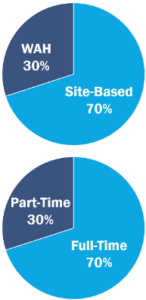
Optimization of workforce schedules is a primary driver of productivity in the contact center. Best practices that enable flexible scheduling and dramatically boost workforce productivity include:
- The addition of work-at-home (WAH) resources for variable scheduling
- The use of part-time staffing to gain additional coverage as needed
- Innovative scheduling and management of resources through the use of sophisticated workforce management tools and processes
As a caution, when utilizing WAH and part-time staff, the organization must establish realistic parameters for the level of flexibility expected from the workforce.
PRODUCTIVITY THROUGH FLEXIBLE STAFFING
 Full-time shifts have been the traditional contact center staffing model for decades, with firms that have seasonal or intra-day volatility relying on part-time resources to cover peak periods. More recently, the addition of WAH staffing has provided additional flexibility. While the requirements for WAH and part-time resources vary based on a firm’s contact center operating model, a 70%/30% mix of site-based to WAH and/or full-time to part-time resources should enhance staffing flexibility and workforce productivity.
Full-time shifts have been the traditional contact center staffing model for decades, with firms that have seasonal or intra-day volatility relying on part-time resources to cover peak periods. More recently, the addition of WAH staffing has provided additional flexibility. While the requirements for WAH and part-time resources vary based on a firm’s contact center operating model, a 70%/30% mix of site-based to WAH and/or full-time to part-time resources should enhance staffing flexibility and workforce productivity.
The workforce management (WFM) team should document and communicate the options for flexibility including changes to start/end times and the use of on-demand scheduling. In general, flexibility around shift start/end times should be within specific parameters (e.g., start or end times may vary +/- 2 hours). For part-time or WAH agents who have accepted on-demand scheduling for at least a portion of their shift, WFM should specify the number of on-demand hours the agent will be expected to contribute on a weekly or monthly basis. On-demand is an efficient way to manage peak hours and unexpected workload surges and can account for >10% of an agent’s schedule, with 90% of the schedule fixed. Part-time also offers the opportunity to increase hours without increasing physical headcount if part-time resources pre-commit to expanding their schedules during high volume periods.
REDUCING THE COST OF SCHEDULE
Efficient staffing requires an accurate workload forecast that translates into agent requirements throughout the day. Econometric models combined with sophisticated WFM tools deliver the functionality to minimize cost of schedule inefficiencies through optimized schedules based on accurate forecasts.
WFM TOOLS
WFM tools/applications reduce the cost of schedule by optimizing workforce productivity through the scheduling of off-phone activities (OPA) during intervals with excess staffing levels. Additionally, advanced WFM tools such as Pipkins Vantage Point track agent adherence and automate exception and modification processing for agent schedules when the variance is driven by a long call. This functionality not only provides a more accurate view of OPA compliance, it also eliminates the manual entry of exceptions, thereby reducing staff support requirements.
STAFFING BUFFER
The use of a buffer (scheduling staff above required levels) enables a firm to staff down through the use of voluntary time off (VTO). Real-time intra-day management of resource levels ensures productivity while also avoiding overtime during unexpected surges. The secrets to successful utilization of a staffing buffer include:
- Have a sufficient buffer, generally 5% to 10%, to ensure VTO can be offered as needed to reduce staffing when above forecasted levels.
- Create VTO demand by making it available on a first come, first served basis. VTO offered multiple times per week or in limited hours within a day increases agent receptivity to the process; excessive availability of VTO results in less demand.
NON-TRADITIONAL SCHEDULES
PART-TIME
Part-time WAH and brick and mortar (BAM) agents can work split shifts and provide peak hour coverage for shorter time periods (e.g., one to two hours); coverage is achieved without increasing the full-time workforce which can result in excess staffing levels in intervals that border the peak periods.
WAH SPLIT SHIFT & ON-DEMAND/VARIABLE
- WAH staff no longer have to travel to the office and can often accept split shifts, thereby giving the WFM team the opportunity to smooth coverage levels.
- Similar to part-time, WAH staff may be leveraged as on-demand or variable resources with a requirement to accept a minimum number of variable hours per week. Some firms even allow agents to build their own schedule based on available hours. This provides the contact center with flexibility (WFM publishes the hours needed) while providing the agent a choice in hours worked (a proven contributor to employee satisfaction).
BLENDED PT/FT
For organizations with unusual workload distributions, schedules offered to a single agent may blend part-time/full-time shifts. For example, if 75% of the monthly workload arrives in the first 8 days of the month, agents may elect full-time schedules for the first 8 workdays with reduced hours or fewer days worked for the remainder of the month.
RELIEF/FLOATING
Relief or floating shifts are another technique for driving productivity. In this approach a subset of agents without defined shifts will bid for a relief shift on a monthly or bi-monthly basis. They essentially assume the shift of individuals who are out due to PTO or leaves. The relief options should reflect actual gaps in the planned schedule or may also reflect additional coverage requirements due to changing trends in workload arrival patterns.
SUCCESS FACTORS
As workload patterns fluctuate due to market factors, service interruptions, or even global pandemics such as COVID-19, WFM teams must think outside the proverbial box and can no longer staff contact centers “the way we’ve always done it.” Firms that take creative or alternative approaches to reduce the cost of schedule while also protecting service level can successfully deliver optimal productivity. And, in addition to achieving customer and business goals, the employee flexibility inherent in alternative staffing approaches may ultimately deliver the rare stakeholder trifecta.






